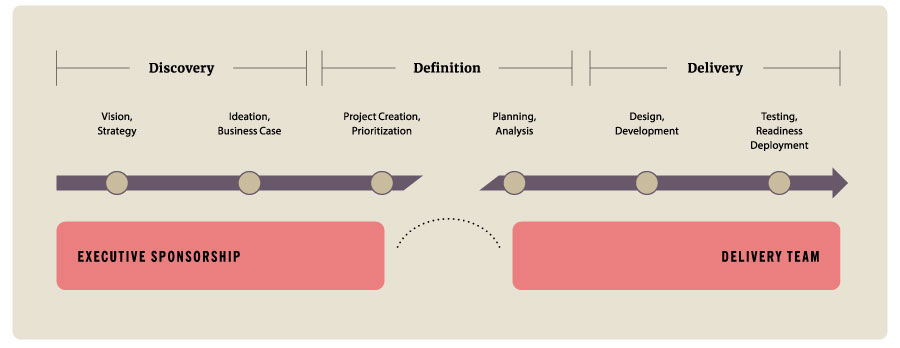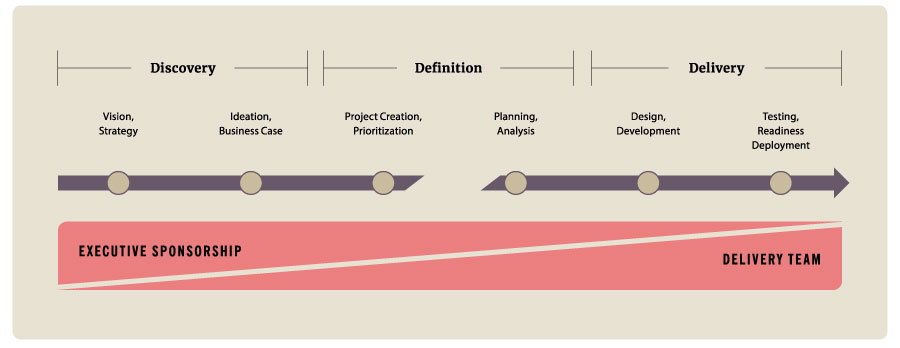Organizations across industries around the globe allocate substantial time and resources to improving the success rate of their project investments. Their efforts often manifest as operational initiatives to implement new delivery methods, adopt new tools and technologies, improve processes, or redesign organizational structures. Given that 15 percent of all projects are considered failures, according to a 2018 Project Management Institute (PMI) study,1 it’s easy to understand the urgency to improve upon these critical areas.
Given the broad emphasis on improving the mechanics of solution delivery, and the relatively slow rate of improvement for project success throughout the years, could we be overlooking a key variable resting in plain sight?
According to PMI, executive sponsor engagement has been cited as the number one driver of project success for the past six years running,1 and these issues are not unique to traditional waterfall delivery environments. VersionOne cites inadequate management and sponsorship support as one of the top challenges to adopting and scaling agile methods as well.2
To maximize the likelihood of project success in the near-term and on an ongoing basis, organizations’ efforts to improve solution delivery operations must include corresponding efforts to strengthen the connection between executive sponsorship and delivery teams. To address these challenges, it is first important to understand some of the underlying causes.

The Communication Gap
Geographical distribution, organizational reporting structures, and other factors can fuel the emergence and continuance of virtual gaps between executive sponsorship and delivery personnel, resulting in a lack of needed collaborative interaction.
Often, such a gap results from the notion that executive sponsorship’s role in the solution delivery process ends or is diminished after discovery. During this time they provide initial direction in the form of a kickoff overview or high-level artifact. After this, the project can enter the “black box” of delivery.
Communication in a cross-gap scenario is often infrequent, impersonal, and inefficient and is handled via documents and review sessions rather than collaborative dialog. To increase the odds of project success, frequent calibration checks are needed to ensure that the emerging solution, from ideation through design and delivery, remains aligned with the sponsor’s purpose, vision, and criteria for success.
Without the sense of connectedness and shared accountability resulting from teamwork in support of a common objective, it is easy to focus solely on one’s own piece of the solution rather than the whole of what is needed. Additionally, virtual “business” and “technology” silos create a lack of awareness of and empathy for the effects of decisions and actions on both sides of the divide that greatly influence a project’s eventual success or failure.

Bridging the Gap
Because adapting behavior to create more engagement between executive sponsors and delivery teams involves changing long-standing habits and boundaries, moving the needle in a positive direction takes time and effort. It is also important to underscore that issues of executive sponsorship engagement are not the sole responsibility of executive sponsorship to resolve. As is often the case when it comes to bringing two sides closer together, effort and patience are required on both sides.
Fortunately, issues of executive sponsorship can usually be improved upon without substantial new initiatives or expenditures, and there are small steps any organization can begin to take immediately.
The following are a few recommendations to improve engagement between executive sponsors and delivery teams that can be used to create quick wins and develop momentum toward more meaningful and lasting changes:
1. Link recommended behaviors to desired outcomes.
Perhaps the most obvious starting point is to help executive sponsors and delivery team members envision how specific behaviors to increase cross-over collaboration will make a positive difference. Explain to both sides what is needed of them, when it is needed, and why. Clearly linking any new or different responsibilities or interactions to the benefits that increase the likelihood of successful project outcomes makes the investment of additional time and effort attractive and worthwhile.
For example, when executive sponsors engage delivery team members earlier—even in a light-touch capacity during early business case ideation and development—it helps team members understand the project’s purpose and goals and provides valuable context in a way that is not conveyable via a project brief or work request. At this early stage, delivery personnel can, in turn, help executive sponsorship specify objectives and success criteria in a way that is more easily consumable by their delivery counterparts downstream as they create specifications, designs, and tests and develop the end product.
Maintaining executive sponsorship participation later—even in a light-touch capacity—during project definition and delivery helps leadership understand and empathize with the challenges associated with unclear goals and changing priorities. Cadenced involvement also provides natural checkpoints, ensuring that both sides stay aligned and on track and that changes and issues get prompt attention.
2. Keep plans simple and focus on small wins.
Once executive sponsors and delivery teams understand why they need to make moderate changes to when, how often, and how they interact, it is important to codify the changes in the form of a simple change management plan or charter that clarifies roles and lists targeted changes and timelines that all can agree to adopt.
It is important to note that committing to manageable, incremental changes over time is often more lasting and effective than a “big bang” approach. With a solid plan for change, a commitment to accountability, and a little momentum accumulated through small wins—increasing executive engagement and support begins to sell itself.
3. Use common reference models and visuals to create a shared understanding.
Delivery team members should strive to develop fluency in the language of the business. In turn, business sponsors should endeavor to understand the fundamentals of delivery process and technology capabilities. Neither needs to become an expert in the other’s arena, just to gain a working knowledge on both sides. Of course, the best way to develop this cross-fluency is through regular, cadenced interaction.
Use of collaborative visual modeling techniques that are commonly understood by business and delivery personnel—whiteboard drawings, visual process flows, wireframes, and mock-ups—can also go a long way toward establishing understanding and a common vocabulary while overcoming perceived “language” barriers.
4. Consider proxies for day-to-day engagement.
In the best of worlds, executive sponsor stakeholders have limited time and are often spread across multiple project engagements. To provide needed support while balancing executive schedules, some organizations implement embedded product managers, business analysts, or other authoritative proxies to supplement day-to-day solution delivery support. While not an ideal substitute, this approach accounts for the realities of executive availability while providing delivery teams with a daily contact and an avenue for escalation.
Delivery team members should strive to develop fluency in the language of the business. In turn, business sponsors should endeavor to understand the fundamentals of delivery process and technology capabilities.
